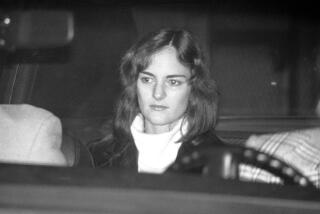Charles Bates; FBI Agent Led Hearst Case
- Share via
Charles Bates got this question “10,000 times” between Feb. 4, 1974, and Sept. 18, 1975: Why can’t you catch her?
He always answered the same way. “I said, ‘I can and I will. I just don’t know when.’ ”
Bates, who died Thursday in Redwood City, was the agent in charge of the FBI’s San Francisco office 25 years ago. The object of fervent interest was Patty Hearst, the newspaper heiress abducted from her Northern California home in what Bates would call the first political kidnapping in this country.
The Hearst case, where the kidnap victim eventually became a fugitive, was the biggest in the 36-year career of Bates, who was 79 at his death at Sequoia Hospital after a stroke.
Most of the FBI was involved in the manhunt at some point, and the FBI said at the time that it interviewed 25,000 people in the San Francisco area.
Just after 2 p.m. on Sept. 18, 1975, Hearst was apprehended at a house in San Francisco with Symbionese Liberation Army associate Wendy Yoshimura. Their capture came “after a lot of digging--and I mean digging,” Bates said of the meticulous background search of Yoshimura that led agents to the San Francisco house where the heiress and Yoshimura were found.
Bates told The Times in a rare interview that quiet surveillance of Yoshimura’s companions--Kathleen, Josephine and Steven Soliah--led agents to a duplex on Morse Street. The Soliah sisters had been roommates of Hearst’s co-fugitives, William and Emily Harris.
The agents had turned up the address of the Soliah sisters. The day before the arrests they saw a man resembling William Harris emerge from the residence. An agent tailed the man to a nearby laundry, went inside and even nodded to the fugitive.
The next morning, agents watched as the man and a female companion went jogging. “When they came jogging back up to the house,” Bates said, “we nailed them.” It was the Harrises.
As they were being driven to FBI headquarters, other agents went to another address traced to the Soliahs and knocked on the door. It was 2:25 p.m. Yoshimura opened the door. Hearst was standing right behind her.
Frank Perrone, a retired agent who worked with Bates during the Hearst investigation, said one word summed him up: Thorough.
“To him everything was a challenge and he did it professionally. It was his job. And he believed every job had to come to a logical conclusion.”
Bates never expressed an opinion publicly about Hearst’s complicity in the bizarre series of crimes that began with her abduction. At her arrest, Hearst gave her occupation as “urban guerrilla,” but she later claimed that she had been brainwashed into cooperating with her captors in the bank robbery that sent her to federal prison for two years.
Bates later supported her 1978 petition for clemency. In a letter to then-U.S. Atty. Gen. Griffin B. Bell, he said he wasn’t swayed by “considerable newspaper publicity to get a pardon for Miss Hearst,” or by organized letter-writing campaigns that had inundated the Justice Department with appeals for her early release.
He supported clemency, he said, “because I am intimately aware of all of the details of this investigation” and because Hearst, who had no prior criminal record, had already “served a sufficient time” in prison.
Hearst’s sentence was commuted by President Jimmy Carter in 1979 after she had served 23 months of a seven-year sentence for bank robbery and weapons violations. She was released from federal prison on Feb. 1, 1979.
After the Hearst case, Bates handled another sensational case, the kidnapping of 26 Chowchilla children and their school bus driver in 1976. That case ended in the victims’ release without injury. Three men were arrested and convicted.
Bates also oversaw the initial stages of the Watergate investigation, but sought a transfer from the Washington headquarters to San Francisco because he said he didn’t care for central office work.
He dismissed as untrue the reports that he left the case under pressure to look the other way. That, he said, “wouldn’t have stopped me.” But he said he knew that people were lying to cover up the wiretapping of Democratic national headquarters.
“Very few people tell the FBI the truth,” he said in 1977.
After his retirement from the bureau, Bates briefly worked as a private investigations consultant and as an investigative reporter for KGO-TV in San Francisco.
He also ran unsuccessfully for San Mateo County sheriff in the 1980s.
Born in Lewisville, Texas, he attended Southern Methodist University and joined the FBI in 1941. He worked for the FBI in Omaha, Buffalo, Newark, Washington, D.C., and Cleveland.
He is survived by his wife, Arlene, a former San Mateo County sheriff’s deputy he met during the Hearst investigation; two daughters; a stepson; five grandchildren; and one great-grandson.
Funeral services will be held at 10 a.m. Tuesday at the Menlo Park Presbyterian Church, 950 Santa Cruz Ave., Menlo Park. Contributions may be made to the FBI Memorial College Education Fund, P.O. Box 250, New Rochelle, N.Y. 10801.
More to Read
Sign up for Essential California
The most important California stories and recommendations in your inbox every morning.
You may occasionally receive promotional content from the Los Angeles Times.














